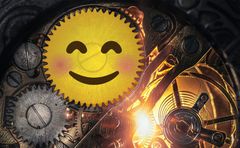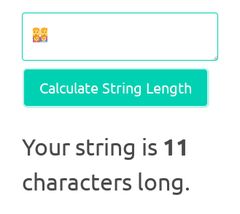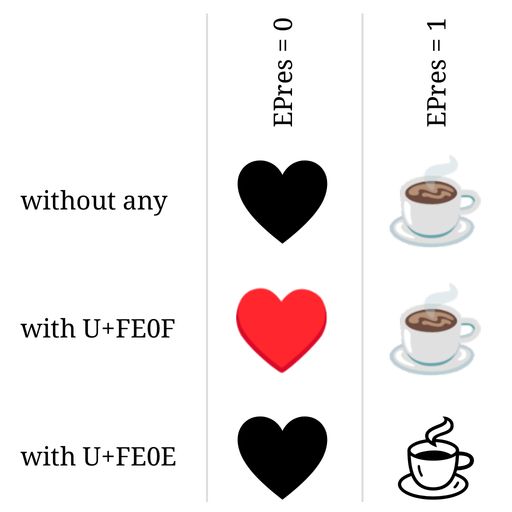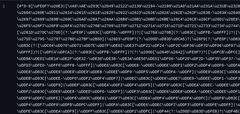Emojis under the Hood

Some love them, some loathe them, but emojis are now indisputably a central part of the day-to-day communication of billions of people around the world. Since their invention in the late 90’s their number grew from 176, a set that made it into the Museum of Modern Arts, to far over 3,700 (as of April 2024).
Their incorporation into the Unicode standard was flanked by more and more requests to extend their expressiveness and their adaptability, and by impatient vendors pressing ahead with their own custom emojis.
Today we want to take a look under the hood of the emoji mechanics and identify the parts that make an emoji an emoji.
Peculiarities
The details that we look into below will allow us to explain some seemingly strange occurences when working with emojis. For example, if you’re allowed only a given amount of characters in a web form, and you enter the “Family: Woman, Woman, Girl, Boy” emoji 👩👩👧👦, then you’ll likely notice the counter going down by 7, although it looks like only a single character was added.

When you then start deleting the emoji again, the counter will go down by one, while the emoji changes to 👩👩👧. Another hit on the delete button keeps the emoji, but the counter still goes down by one.
On the other hand simply pasting the “Family” emoji 👪 doesn’t show any of those peculiarities. It acts exactly as you’d expect any other character to behave.
Sometimes emojis become monochromous, when you try to delete them. Sometimes they change to tofu. Let’s look at the mechanics at work that lead to these behaviours!
Emojis in Unicode
The technicalities are specified in Unicode’s technical report #51. This document details, which code points can act as emojis and under which circumstances. It is accompanied by the actual data, the concrete list of emojis as defined by Unicode.
Some code points have special properties that mark them as part of the emoji world. Those code points and their properties are listed in a separate file of the Unicode data folder.
Finally the CLDR project collects a name (and possible aliases) for each emoji in different languages, e.g. in English. This data is used by Emoji picker widgets to let you search for emojis by name.
And to get this out of the way: Yes, you can propose a new emoji, but the bar for inclusion is high, and you will be asked to thoroughly proof the actual need.
Anatomy of an Emoji
Let‘s go back to the technical report #51 and the special properties mentioned above. They are specified in chapter 1.4 and comprise:
Emoji: code points with this property can be an emoji or be part of an emojiEmoji_Presentation: a single emoji code point can be either a (usually) colorful emoji or a monochromous “normal” glyph as default. Code points with this property should be rendered as colorful emojis. We will see later, how we can switch from one presentation mode to the other.Emoji_Modifier: a code point, that can change the appearance of another emoji preceding it. An example are skin tones.Emoji_Modifier_Base: an emoji code point, that actually can be modified by a preceding emoji modifier.
Single Code Point Emojis
This knowledge allows us to identify the composition of the most simple emojis, the emoji characters:
- Code points with the property
Emoji_Presentationare stand-alone emojis.
What about characters that have the Emoji property but not the
Emoji_Presentation property? To convert them into an emoji they have to have
the special code point U+FE0F (named “Variation Selector 16”)
appended. This converts them into the colorful representation.
- Code points with the
Emojiproperty together with an appended code point U+FE0F are emojis.
Note that not all code points with the Emoji property can be converted to
emojis this way. The notable exceptions are the modifiers. Curiously enough,
the digits 0 to 9 however can be emojified this way.
The opposite is possible as well with these emojis. If you add a Variation Selector 15, U+FE0E, to any of them, they are forced into the monochromous “normal glyph” mode.

To describe whether a certain string is definitively an emoji or only maybe, Unicode uses the labels “fully qualified” (yep, definitively rendered as an emoji!), “unqualified” (nope, surely not rendered as an emoji) and “minimally qualified” (¯\(ツ)/¯ might become an emoji, if you add an U+FE0F).
Great! We know now a good deal about single-code-point emojis! On to the next step!
Emoji Sequences
When the interest in and demand for emojis started to take off, a lot of variations for existing emojis were requested, e.g., changing of skin tone or gender, more than the original 10 flags, and so on.
Now, instead of creating hundreds of new code points for every possible emoji the Unicode consortium decided to specify sequences of code points to represent a single emoji. This is similar to how some diacritics in Unicode work. The technical term for such a construction is a grapheme.
For example, if you combine U+0061 and U+0308 you get an a with an umlaut, “ä” (which is the same as U+00E4 actually, but that is a topic for a different post).
What we’re dealing with, then, are several code points in a row, that will end up on screen as a single emoji. This is in itself a worthwhile idea, but we will see that the devil is in the detail here. And a fiendish Beelzebub this is!
Flags
Let’s start with a fairly easy one: flags.
Early emoji sets already hard-coded some flags like 🇯🇵 Japan and 🇺🇸 USA. When it came to encoding the remaining country flags, Unicode had no mind to deal themselves with the question of what is or isn’t a country. They outsourced this to the ISO 3166-1 standard and created a set of 26 “regional language indicators” that are used to build a flag emoji from a pair of them.
- Flag emojis consist of two code points from the set U+1F1E6..U+1F1FF that represent an existing ISO 3166-1 country code.
Unless when they aren’t. See, the UK, um, ... I mean GB, or...
the ... Commonw... this entity that encompasses parts of the British Isles had
needs unmet by this definition. And to encode the English, Welsh, and Scottish
flags, Unicode went back to the drawing board and pulled
another set of code points out of their hat.
- Regional flags consist of the Black Flag U+1F3F4 and a series of tag characters finished by U+E007F.
And that’s how to encode emoji flags. Apart from the Transgender flag. Or the Skull & Crossbone flag. Or the Rainbow flag. Or the Checkered flag. Terence Eden has a good overview, if you want to read on on emoji flags.
Zero-Width-Joiners
There are times when you want to combine two emoji concepts to form another emoji. For example, if you want to represent a woman mechanic 👩🔧, you could use 👩 and 🔧 somehow. And indeed this is how the emoji is defined, with the magic codepoint U+200D in between both.
U+1F469 + U+200D + U+1F527 = Woman Mechanic emoji
Woman ZWJ Wrench
U+200D is named the “zero-width joiner” or ZJW for short. It’s original use case is to force a character into its joining form, even if it stands isolated. For example, in Arabic “me” is أنا, where the middle character is ن. Note, that it looks differently in its isolated form than when it is connected to the left above.
The ZWJ now helps you in tasks like “show how ن looks like in أنا”. Think e.g. of teaching books for Arabic. Then append an U+200D to the letter and it combines with... well, with nothing actually: ن. (You might not see a difference here depending on the text layout system your computer uses.)
- ZWJ sequences are sequences of base emojis joined by a U+200D codepoint.
Families are constructed this way, too. While the “base family” emoji is a single code point U+1F46A, any combination like “Man, Man, Boy, Girl” is combined of several separate emojis, each joined with a U+200D:
U+1F468 U+200D U+1F468 U+200D U+1F467 U+200D U+1F466 = 👨👨👧👦
Man ZWJ Man ZWJ ZWJ Girl Boy
Let’s come back to the intro of this post, where we noticed something strange when hitting the backspace key at the end of a family emoji. Now we can explain what happens. The backspace key doesn’t delete the whole emoji. Instead it deletes only the last code point. This results in the sequence
U+1F468 U+200D U+1F468 U+200D U+1F467 = 👨👨👧
Man ZWJ Man ZWJ Girl
a different emoji, and a trailing U+200D.
Modifier Sequences
One modification to emojis is so common, that Unicode introduced another way of representing it. Skin tones do not need the U+200D glue. They are directly attached to their base emoji. Under the hood Unicode represents this feature with the “Emoji Modifier” property mentioned above that is true for these five codepoints.
- Modifier sequences are base emojis followed by a modifier. They can also appear as components in a ZWJ sequence.
To change the skin tone of a base emoji you append the appropriate skin tone modifier like this:
U+1F469 U+1F3FD = 👩🏽
Woman Medium Skin Tone Woman with medium skin tone
You can then use such a modified emoji in a more complex ZWJ sequence, too:
U+1F469 U+1F3FD U+200D U+1F9B0 = 👩🏽🦰
Woman Medium Skin Tone ZWJ Red Hair Woman with medium skin tone and red hair
Keycap Sequence
The last type of sequence traces back to the old days of the very first emoji standard in 2014. It was a kind of ad-hoc lumping together of codepoints to simulate the keys on a telephone key pad. Emoji versions of them were present almost from the beginning in the late ’90s in SoftBank’s and KDDI’s emoji sets.
The structure is quite simple: Take a literal digit or one of * or # and
append a variation selector U+FE0F and U+20E3 Combining Enclosing Keycap.
Presto! Emojis.
- Keycap sequences consist of one character from the set
[0-9*#], a variation selector 16 and a combining enclosing keycap.
That’s more or less all ways emojis can be constructed.
Non-standard Emojis
I say “more or less”, because sometimes vendors go wild with their own ideas for new emojis. And while currently all known additions adhere to the types of sequences defined by Unicode, there is no guarantee that this will stay true in the future.
The Unicode Consortium acknowledges this fact. It comments its list of emojis therefore with the label “Recommended for General Interchange” or “RGI”. On the other hand this makes all emojis not on the list “non-RGI” and thus possibly not safe to exchange between different platforms or apps.
An example for a non-RGI emoji is “Woman in Business Suit Levitating, Light Skin Tone”. This emoji is currently only supported by Twitter and Facebook and not yet standardized by Unicode.
Sometimes non-RGI emojis become so widely used that Unicode picks them up in the official standard. This happened with the pirate flag emoji 🏴☠️, introduced by Twitter in 2016 and added to Unicode in 2018.
Detecting Emojis in Plain Text
In principle we’ve got now a finite list of ways to make emojis. However, given the possible combinations (like family members), invalid compositions (like skin tone modifiers on 🌴), instable world politics (that might change what is or is not a flag emoji) and future extensions, it is all but trivial to detect emojis in a string of text. Doing this with a regular expression increases your Javascript code base by 12.5 KB.

At the end of the day this is, however, often the most reasonable route to take for arbitrary texts.
If you are the author of the source text, too, it is often better to use
placeholders instead of the actual emojis. Many new chat interfaces, from
WhatsApp to Slack support so-called shortcodes with colons, like :palm_tree:,
and map them onto emojis in a second step. These codes are easier to match in
code, and sometimes even easier to write.
Where Are We Standing Now?
Charlotte Buff gives us a good overview how the raw string lengths are distributed between emojis.
But even now that we know how emojis are created it is all but trivial to determine the actual composition of a given emoji. In most cases the best way is to enter it into a code point analyzer to see what it is actually made of, or to search it in the Emojipedia.
Luckily in most cases it is completely irrelevant what code points make up a given emoji, exactly as irrelevant in day-to-day communication whether an “ä” is a U+0061-U+0308 combination or a U+00E4. But if we encounter a strange situation where seemingly unexplicable emoji phenomenons appear we now have the tools to explain their nature.
To conclude this post, here are again the 6 ways official Unicode emojis can be structured as handy overview:
| # | description | example |
|---|---|---|
| 1. | single code points, with or without U+FE0F added | U+1F602 ⇒ 😂; U+262F + U+FE0F ⇒ ☯️ |
| 2. | keycap sequences | “1” + U+FE0F + U+20E3 ⇒ 1️⃣ |
| 3. | modifier sequences | U+1F64B + U+1F3FD ⇒ 🙋🏽 |
| 4. | flag sequences with regional indicators | U+1F1E6 + U+1F1F6 ⇒ 🇦🇶 |
| 5. | flag sequences with tags | U+1F3F4 + U+E0067 + U+E0062 + U+E0077 + U+E006C + U+E0073 + U+E007F ⇒ 🏴 |
| 6. | emoji sequences with zero width joiner | U+1F469 + U+200D + U+1F680 ⇒ 👩🚀 |
N.B. The original Japanese plural of “emoji” is “emoji”, too. However, according to the Emojipedia the anglicised plural “emojis” has meanwhile also become OK.
P.S. Many thanks to Terence Eden and Charlotte Buff for spotting and correcting some errors!